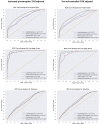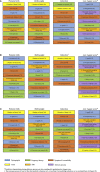Quantifying the Impacts of Pre- and Post-Conception TSH Levels on Birth Outcomes: An Examination of Different Machine Learning Models
- PMID: 34777251
- PMCID: PMC8586450
- DOI: 10.3389/fendo.2021.755364
Quantifying the Impacts of Pre- and Post-Conception TSH Levels on Birth Outcomes: An Examination of Different Machine Learning Models
Abstract
Background: While previous studies identified risk factors for diverse pregnancy outcomes, traditional statistical methods had limited ability to quantify their impacts on birth outcomes precisely. We aimed to use a novel approach that applied different machine learning models to not only predict birth outcomes but systematically quantify the impacts of pre- and post-conception serum thyroid-stimulating hormone (TSH) levels and other predictive characteristics on birth outcomes.
Methods: We used data from women who gave birth in Shanghai First Maternal and Infant Hospital from 2014 to 2015. We included 14,110 women with the measurement of preconception TSH in the first analysis and 3,428 out of 14,110 women with both pre- and post-conception TSH measurement in the second analysis. Synthetic Minority Over-sampling Technique (SMOTE) was applied to adjust the imbalance of outcomes. We randomly split (7:3) the data into a training set and a test set in both analyses. We compared Area Under Curve (AUC) for dichotomous outcomes and macro F1 score for categorical outcomes among four machine learning models, including logistic model, random forest model, XGBoost model, and multilayer neural network models to assess model performance. The model with the highest AUC or macro F1 score was used to quantify the importance of predictive features for adverse birth outcomes with the loss function algorithm.
Results: The XGBoost model provided prominent advantages in terms of improved performance and prediction of polytomous variables. Predictive models with abnormal preconception TSH or not-well-controlled TSH, a novel indicator with pre- and post-conception TSH levels combined, provided the similar robust prediction for birth outcomes. The highest AUC of 98.7% happened in XGBoost model for predicting low Apgar score with not-well-controlled TSH adjusted. By loss function algorithm, we found that not-well-controlled TSH ranked 4th, 6th, and 7th among 14 features, respectively, in predicting birthweight, induction, and preterm birth, and 3rd among 19 features in predicting low Apgar score.
Conclusions: Our four machine learning models offered valid predictions of birth outcomes in women during pre- and post-conception. The predictive features panel suggested the combined TSH indicator (not-well-controlled TSH) could be a potentially competitive biomarker to predict adverse birth outcomes.
Keywords: birth outcomes; machine learning; post-conception; preconception; thyroid-stimulating hormone (TSH).
Copyright © 2021 Sun, Zheng, Zhang, Zhao, Li, Zhang, Ma, Tian, Yu, Xiao, Jin and Hua.
Conflict of interest statement
The authors declare that the research was conducted in the absence of any commercial or financial relationships that could be construed as a potential conflict of interest.
Figures


Similar articles
-
Prediction and feature selection of low birth weight using machine learning algorithms.J Health Popul Nutr. 2024 Oct 12;43(1):157. doi: 10.1186/s41043-024-00647-8. J Health Popul Nutr. 2024. PMID: 39396025 Free PMC article.
-
Prediction of preterm birth in multiparous women using logistic regression and machine learning approaches.Sci Rep. 2024 Sep 20;14(1):21967. doi: 10.1038/s41598-024-60097-4. Sci Rep. 2024. PMID: 39304672 Free PMC article.
-
Predicting low birth weight risks in pregnant women in Brazil using machine learning algorithms: data from the Araraquara cohort study.BMC Pregnancy Childbirth. 2025 Mar 19;25(1):320. doi: 10.1186/s12884-025-07351-3. BMC Pregnancy Childbirth. 2025. PMID: 40108493 Free PMC article.
-
A Novel Nomogram for Predicting the Risk of Premature Delivery Based on the Thyroid Function in Pregnant Women.Front Endocrinol (Lausanne). 2022 Jan 10;12:793650. doi: 10.3389/fendo.2021.793650. eCollection 2021. Front Endocrinol (Lausanne). 2022. PMID: 35082756 Free PMC article.
-
Association of Thyroid Function Test Abnormalities and Thyroid Autoimmunity With Preterm Birth: A Systematic Review and Meta-analysis.JAMA. 2019 Aug 20;322(7):632-641. doi: 10.1001/jama.2019.10931. JAMA. 2019. PMID: 31429897 Free PMC article.
Cited by
-
Prediction models and associated factors on the fertility behaviors of the floating population in China.Front Public Health. 2022 Sep 9;10:977103. doi: 10.3389/fpubh.2022.977103. eCollection 2022. Front Public Health. 2022. PMID: 36187657 Free PMC article.
-
Potential genetic biomarkers predict adverse pregnancy outcome during early and mid-pregnancy in women with systemic lupus erythematosus.Front Endocrinol (Lausanne). 2022 Nov 16;13:957010. doi: 10.3389/fendo.2022.957010. eCollection 2022. Front Endocrinol (Lausanne). 2022. PMID: 36465614 Free PMC article.
-
Predicting risk of preterm birth in singleton pregnancies using machine learning algorithms.Front Big Data. 2024 Feb 29;7:1291196. doi: 10.3389/fdata.2024.1291196. eCollection 2024. Front Big Data. 2024. PMID: 38495848 Free PMC article.
-
Artificial Neural Network Modeling to Predict Neonatal Metabolic Bone Disease in the Prenatal and Postnatal Periods.JAMA Netw Open. 2023 Jan 3;6(1):e2251849. doi: 10.1001/jamanetworkopen.2022.51849. JAMA Netw Open. 2023. PMID: 36689226 Free PMC article.
References
-
- Garber JR, Cobin RH, Gharib H, Hennessey JV, Klein I, Mechanick JI, et al. . Clinical Practice Guidelines for Hypothyroidism in Adults: Cosponsored by the American Association of Clinical Endocrinologists and the American Thyroid Association. Endocr Pract (2012) 18(6):988–1028. doi: 10.4158/EP12280.GL - DOI - PubMed
-
- Su PY, Huang K, Hao JH, Xu YQ, Yan SQ, Li T, et al. . Maternal Thyroid Function in the First Twenty Weeks of Pregnancy and Subsequent Fetal and Infant Development: A Prospective Population-Based Cohort Study in China. J Clin Endocrinol Metab (2011) 96(10):3234–41. doi: 10.1210/jc.2011-0274 - DOI - PubMed
Publication types
MeSH terms
Substances
Grants and funding
LinkOut - more resources
Full Text Sources
Medical
Miscellaneous

